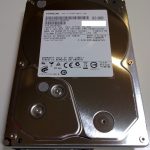
For so little money, it seems like it doesn’t really matter which hard disk I get. After all, my PC isn’t anywhere near “cutting edge”, surely any of today’s hard disk would be more than good enough for it. Still, it’s good to do a little bit of research.
A couple of friends tell me to avoid Seagate. Considering that the failing disk is from Seagate too, I tell myself to avoid it too. So apart from Seagate, the main choices for 1TB disks aredown to Western Digital and Hitachi. I’m not very impressed with Western Digital, and I actually haven’t thought much about Hitachi either. But it seems like Hitachi disks are quite well received, and they are actually descended from IBM’s storage division when Hitachi bought them out earlier in this millennium. The Deskstar hard disks from IBM then were quite well known (first it was bad, but later it was better).
So it was the Hitachi hard disk that I was going to get: the 7K1000.C model. Apparently the “7K1000.C” isn’t printed anywhere on the disk itself, and fortunately I noted about it and remembered the actual number used: HDS721010CLA332. Why? It turns out the shops in Sim Lim weren’t any helpful either knowing exactly which Hitachi hard disk they had. The first shop, Fuwell, simply showed me the disk and I determined it was the older generation 7K1000.B model. When I did find the 7K1000.C at another shop, they didn’t know about the difference either or how to tell them apart. Good thing for the little bit of homework.
The differences between the 7K1000.B and 7K1000.C models are small. The B is the 2nd generation, while the C is the 3rd generation. If there is no cost difference (the 7K1000.C I bought was actually cheaper from the other shop that carried the 7K1000.B), why not get the latest generation? For the 1TB capacity drives, the 7K1000.C has greater media density (352Gb/sqin vs 244Gb/sqin), greater media transfer rate (1589Mb/s vs 1406Mb/s), more cache (32MB vs 16MB), consumes less power at idle (4.4W vs 5.2W), and is quieter (2.4db vs 2.7db). Oddly enough, the first generation 7K1000 has 32MB cache, which is more than the 2nd generation 7K1000.B.
Installation of the hard disk was a no-brainer. These are commodity components anyway, so for a person familiar with fixing up a PC, there’s nothing really to write about.
I installed Fedora 12, and I thought the installation went a lot faster than it ever did for other versions of Fedora I installed. Of course, the improvement could either be due to a better optimized Fedora itself, or well, the disk is really making a difference. No time to do a real objective benchmark. Nevertheless, I’m pleased that the rather old PC I have (5 years old perhaps) supports SATA2, so I am benefitting from the 3.0Gbps interface speed.
